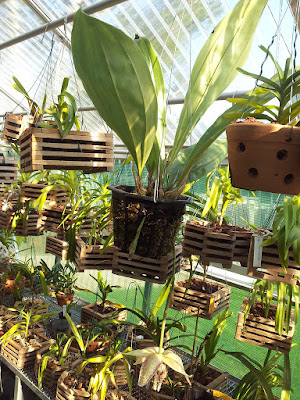Embreea rodigasiana is found in Colombia and Ecuador. It grows epiphyte in extremely wet cloud forests at a height of 500 to 1500 meters above sea level...
Embreea rodigasiana also called as Rodigas' Embreea, Stanhopea rodigasiana, is a species of the genus Embreea. This species was described by Dodson in 1980.
IDENTIFY EMBREEA RODIGASIANA ORCHID PLANT
Embreea rodigasiana is found in Colombia and Ecuador. It grows epiphyte in extremely wet cloud forests at a height of 500 to 1500 meters above sea level.
It is a small sized, warm to cool growing epiphyte with ovoid, 4-angled, pale green, up to 6 cm in height pseudobulbs carrying a single, apical, plicate, suberect, heavily veined beneath, oblanceolate to elliptic-oblong, acute, pale green, up to 50 cm long, and up to 10 cm wide leaf.
Rodigas' Embreea blooms in the spring with a basal, pendant, 8 to 25 cm long, slender inflorescence bearing several sheaths, obovate bracts and a large, solitary, fleshy, short-lived flower. The flowers are from ivory to yellow, about 10 cm in diameter. The sepals are covered with red spots. Lateral sepals ovate, with sharp tips, and upper lanceolate. Petal monophonic, lanceolate, arched. The lip has a very unusual structure, measuring 8 cm long and 3.5 cm wide, white, covered with intense red spots.
EMBREEA RODIGASIANA ORCHID PLANT CARE AND CULTURE
Cultural information should only be used as a guide, and should be to be adapted to suit you. Your physical location; where you grow your plants, how much time you have to devote to their care, and many other factors, will need to be taken into account. Only then can you decide on the cultural methods that best suit you and your plants.
Light:
Embreea rodigasiana loves a bright sun without access to direct sunlight, so during the midday the plant must be put behind a curtain or into the shade of other plants. Otherwise, the orchid can get sunburn.
Temperature:
This type of orchid refers to a warm temperature regime: Day temperature at 20-28 ° C; Night temperature is not below 15 ° C. When growing at home, it is necessary that the night temperature of the content is always 2-3 ° C lower than the daytime temperature.
Humidity:
For normal growth and development Rodigas' Embreea needs the average humidity of 50-70%. The higher of temperature, the higher the humidity of the air, and the higher the humidity of the air, the more often and longer it is necessary to ventilate the room where the orchids are kept, otherwise the decay and appearance of various the genus of fungi.
Substrate, growing media and repotting:
Embreea rodigasiana is usually grow in suspended pots. The substrate must be very well breathable, therefore in its quality the mixture of large pieces of bark of coniferous trees with foam plastic and a fern of Osmund type is best. The best time for transplant is the period immediately after flowering and until the moment when new shoots reach a size of 5 cm and begin to build their own roots.
Watering:
This orchid prefers relatively dry content, so even during the new growth period, this kind of orchids should be watered very carefully, avoiding overflows. Excess water during watering should flow freely out of the pot, as the stagnation of water both inside the pot and in its pan can very quickly lead to decay of the roots and the lower part of the plant. The substrate between waterings should dry well. On hot summer days, when this type of orchid is found in the open air, daily spraying of its outer part is recommended to increase the humidity around the plant. This will help the plant more comfortably to survive the hot period.
Fertilizer:
During the new growth period, this type of orchid is fertilized every two weeks in the usual fertilizer concentration indicated on the package.
Rest period:
Embreea rodigasiana does not need a period of rest to stimulate flowering. After flowering, the flower stem is removed, if necessary, the orchid is transplanted and kept dry for some time. This is necessary to acclimatize the plant and to prevent rotting of the roots from the transplant.















COMMENTS